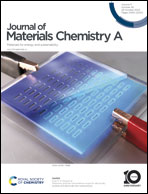Molten salt-directed synthesis of strontium manganese perovskite oxide: an active electrocatalyst for the oxygen reduction reaction and oxygen evolution reaction†
Abstract
We report a molten-salt pathway for the synthesis of strontium manganese perovskite oxide (SMO), its phase transition with the variation of temperature, and demonstrate the intrinsic catalytic behaviour of different phases towards the ORR and OER. This strategic synthesis method forms the products at a comparably lower temperature than the popular solid-state reaction (SSR) approach. Furthermore, the temperature-dependent structural transition of strontium manganese perovskite oxide and its impact on the dynamics of the ORR and OER are recognized. We observed four unique crystal systems with variation of temperature. In comparison with the single phase of SrMnO3, the heterostructure/biphase was formed at 900 °C (SrMnO3/Sr7Mn4O15), which demonstrated high activity due to the cooperative effect in the catalyst. The study reveals that the unique coordination achieved by the stacking of the [Mn2O9] dimer enables favoured interactions between the electrode surface and electrolyte. It was observed further that the formation of biphases in the perovskite oxide produces a defect in the crystal system which has been confirmed by SEM and HRTEM. The resultant biphasic (hexagonal and monoclinic) perovskite-based oxide exhibits remarkable catalytic activity with an onset potential and current density of 0.97 V (vs. RHE) and 5.6 mA cm−2 for the ORR respectively, while the orthorhombic phase was found to be superior for the OER with an overpotential of 490 mV @10 mA cm−2 which is in comparison with the state-of-the-art catalysts. Moreover, the orthorhombic phase obtained at 1000 °C (Sr4Mn3O10) shows the highest electrochemical stability up to 30k cycles with gain in half-wave potential and also exhibits the least bifunctionality index. Interestingly, the cells based on SMO-900 and SMO-1000 as the air electrode in in-house designed zinc–air batteries exhibited outstanding specific capacities of 708 and 640 mA h g−1 respectively, which are much higher compared to those of the standard Pt–Ru/C catalyst with 420 mA h g−1.

- This article is part of the themed collection: #MyFirstJMCA


 Please wait while we load your content...
Please wait while we load your content...